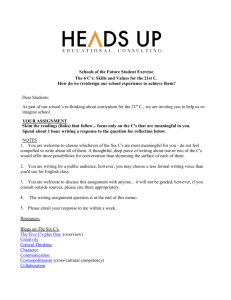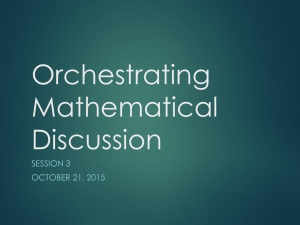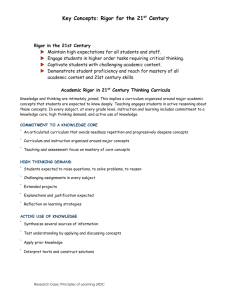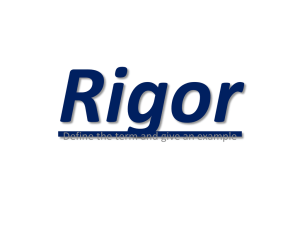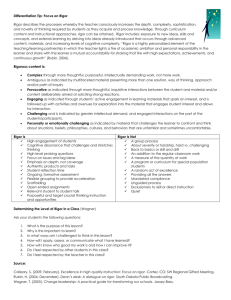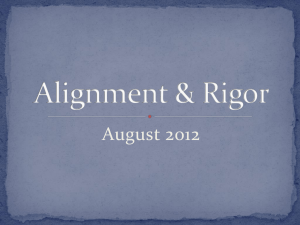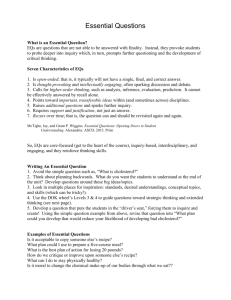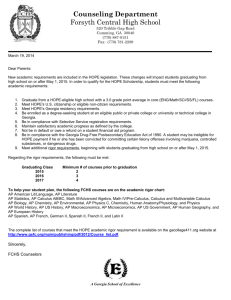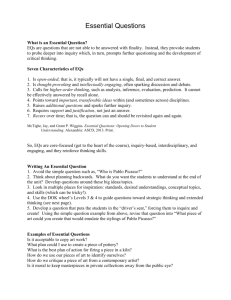Document
advertisement
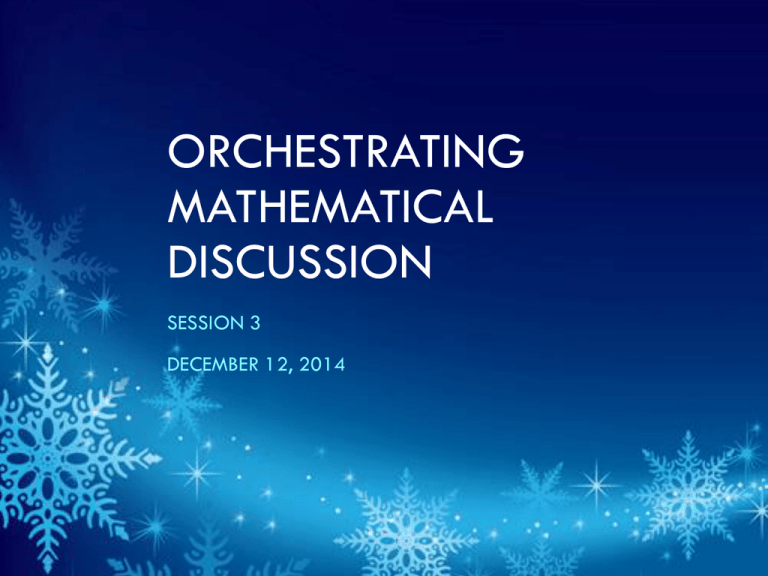
ORCHESTRATING MATHEMATICAL DISCUSSION SESSION 3 DECEMBER 12, 2014 OVERVIEW • • Lesson Sharing Connecting Discussion • Problem Solving • • LUNCH NCTM Principles to Action • • Globe Activity Rigor Discussion PAPERWORK • Before you leave, we need: • SCECH Forms • Substitute Reimbursement Form LESSON SHARING • Share with your content groups how your lesson went • • • • Any challenges Success stories What would you change if you were to run the lesson again? What questions did you ask that provided you with excellent feedback? 15 minutes JIGSAW SHARE • Split into 5 groups of 5 participants. • Each group should have at least one person from each content group, ideally. SHARE PROTOCOL • Describe the strategy and implementation (3 minutes) • Group asks clarifying questions and presenting teacher may respond (2 minutes) • Provide warm and cool feedback (2 minutes) • Reflect based on feedback (1 minutes) REFLECTION • What was the most meaningful/beneficial thing your group learned from this experience? • Would you use this with students? • If so, how would you adjust the questions? BREAK CONNECTING DISCUSSION • 5th Practice for Orchestrating Mathematical Discussions • Most Challenging • Dependent on questioning to reveal student thinking • Link between mathematical ideas and representations to critically consider a mathematical concept. CONNECTING UNIT Sequence Topics and Build Connections Intradisciplinary Interdisciplinary Lesson Sequence Connecting Please sit with your content groups! CANDY PROBLEM SOLVING • Work in groups to solve your assigned method • • • • • Fraction Percent Ratio (Unit Rate) Ratio (Scaling Up) Additive • ** When ready, place your solution method on a poster board CANDY PROBLEM SOLVING • Selecting and Sequencing • How would you select and sequence? • Would you use them all? • Why or why not? LUNCH PRINCIPLES TO ACTIONS • Take the Teaching and Learning Survey independently. • Discuss the highlights from the survey. PRINCIPLES TO ACTION GLOBE ACTIVITY • Use the first sheet to make a quick, independent estimation. GLOBE ACTIVITY • Please take the next 15 – 20 minutes to solve the problem in as many ways as you can find. • Please feel free to work with your peers. Thought Provokers by Doug Rohrer, published by Key Curriculum Press ($3) CIRCLING THE EARTH By Mikayla and Audrey A. PLEASE NOTE That the following presentation is given under the assumption that the earth is perfectly spherical. A Visual Representation The Earth The circumference of the Earth and the Earth’s circumference with the thread. The radius of the Earth and the Earth’s radius with the thread. A BIRDS EYE VIEW / LET STATEMENTS Let r1 be the radius of the earth Let r2 be the radius of the earth with the 100 extra feet of string accounted for EARTH Let c be the circumference of the earth Let c + 100 be the circumference of the earth with the 100 extra feet of string. SOME SIMPLE FORMULAS To solve this problem, one needs to know ONLY this formula: c = 2πr circumference = (2) (π) (radius) AND THE COMPUTATION BEGINS... gap = r2 - r1 gap = c + 100 - c 2π 2π gap = c + 100 - c 2π 2π 2π gap = 100 = 50 2π π C = 2πr r1 = c/2π r2 = c + 100 2π THE FOLLOWING SLIDE TESTS OUR PREDICTED CONCLUSION c + 100 - c 2π 2π Proposed value for c c + 100 2π c 2π 30 20.69014260 4.77648293 15.915494307 250 55.6281864 39.7887357 15.91549438 1,192 205.6281864 189.7126921 15. 9154943 (solution) • THANK YOU FOR VIEWING OUR PRESENTATION! BREAK UNDERSTANDING RIGOR • Definition of Rigor as related to the Mathematics Classroom • Frayer Model • Individually, complete the Frayer Definition Model for the word “rigor” • Once completed, discuss your definition with an elbow partner DEFINING MATHEMATICAL RIGOR • Two aspects of mathematical rigor • CONTENT: Mathematical rigor is the depth of interconnecting concepts and the breadth of supporting skills students are expected to know and understand. • INSTRUCTION: Mathematical rigor is the effective, ongoing interaction between teacher instruction and student reasoning and thinking about concepts, skills, and challenging tasks that results in a conscious connected, and transferable body of valuable knowledge for every student. DEFINING MATHEMATICAL RIGOR • As a table group, discuss your definitions of rigor with the definitions presented by Hull, Balka, and Harbin-Miles. • Where do you agree? Disagree? • (Be prepared to share one or two thoughts with the whole group) RIGOR EXPECTATIONS “SHIFT” • Mathematical rigor requires a shift in beliefs and actions. • In the column in the middle of the chart below, rate where you and/or your students are in thinking related to the shifts required for increased rigor in the classroom. Items in the “Current Tendencies” column would be rated “1”; items in “Future Opportunities” would be a “5”. • Once you are done rating each item, select one or two to discuss with a partner or trio. EVALUATION • Please complete the Evaluation • Submit your substitute reimbursement form • Submit your SCECH Paperwork THANK YOU!
